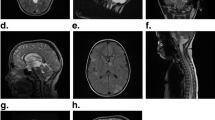Abstract
Glioblastoma multiforme (GBM) is one of the most aggressive tumors in the central nervous system. SEMA6A, the first identified class 6 semaphorin, is contributed to regulate vascular development and adult angiogenesis. However, the function of SEMA6A in GBM is still undefined. In the present study, we investigated the expression of SEMA6A protein in 200 GBM tissues using immunohistochemistry (IHC). SEMA6A expression was associated with time to progression (P = 0.001) and mean tumor diameter (P = 0.038). Kaplan–Meier analysis revealed that patients expressing high SEMA6A protein levels had a significantly longer overall survival (OS, P = 0.013) and progression-free survival (PFS, P = 0.005) compared to those with low SEMA6A expression level. Cox multivariate regression analysis confirmed that low SEMA6A expression was an independent unfavorable prognostic factors for PFS (HR, 1.896; 95 % CI, 1.147–2.768; P = 0.009) and OS (HR, 1.712; 95 % CI, 1.011–2.657; P = 0.012). Furthermore, in vitro experiments showed that SEMA6A could inhibit proliferation, migration, and invasion in different glioma cell lines. In conclusion, our findings indicated that SEMA6A may be a potential prognostic biomarker in the treatment of GBM.



Similar content being viewed by others
References
Wen PY, Kesari S. Malignant gliomas in adults. N Engl J Med. 2008;359:492–507.
Rousseau A, Mokhtari K, Duyckaerts C. The 2007 WHO classification of tumors of the central nervous system—what has changed? Curr Opin Neurol. 2008;21:720–7.
Van Meir EG, Hadjipanayis CG, Norden AD, et al. Exciting new advances in neuro-oncology: the avenue to a cure for malignant glioma. CA Cancer J Clin. 2010;60:166–93.
Semaphorin Nomenclature Committee. Letter to the editor: unified nomenclature for the semaphorins/collapsins. Cell. 1999;97:551–2.
Pasterkamp RJ. Getting neural circuits into shape with semaphorins. Nat Rev Neurosci. 2012;13:605–18.
Gu C, Giraudo E. The role of semaphorins and their receptors in vascular development and cancer. Exp Cell Res. 2013;319:1306–16.
Kumanogoh A, Kikutani H. Immunological functions of the neuropilins and plexins as receptors for semaphorins. Nat Rev Immunol. 2013;13:802–14.
Martin-Satue M, Blanco J. Identification of semaphorin E gene expression in metastatic human lung adenocarcinoma cells by mRNA differential display. J Surg Oncol. 1999;72:18–23.
Deaglio S, Vaisitti T, Bergui L, et al. CD38 and CD100 lead a network of surface receptors relaying positive signals for B‑CLL growth and survival. Blood. 2005;105:3042–50.
Hu B, Guo P, Bar-Joseph I, et al. Neuropilin‑1 promotes human glioma progression through potentiating the activity of the HGF/SF autocrine pathway. Oncogene. 2007;26:5577–86.
Hirota E, Yan L, Tsunoda T, et al. Genome-wide gene expression profiles of clear cell renal cell carcinoma: Identification of molecular targets for treatment of renal cell carcinoma. Int J Oncol. 2006;29:799–827.
Zhou L, White FA, Lentz SI, et al. Cloning and expression of a novel murine semaphorin with structural similarity to insect semaphorin I. Mol Cell Neurosci. 1997;9:26–41.
Bron R, Vermeren M, Kokot N, et al. Boundary cap cells constrain spinal motor neuron somal migration at motor exit points by a semaphorin–plexin mechanism. Neural Dev. 2007;2:21.
Little GE, López-Bendito G, Rünker AE, et al. Specificity and plasticity of thalamocortical connections in Sema6A mutant mice. PLoS Biol. 2009;7, e98.
Mauti O, Domanitskaya E, Andermatt I, et al. Semaphorin6A acts as a gate keeper between the central and the peripheral nervous system. Neural Dev. 2007;2:28.
Rünker AE, Little GE, Suto F, et al. Semaphorin-6A controls guidance of corticospinal tract axons at multiple choice points. Neural Dev. 2008;3:34.
Suto F, Tsuboi M, Kamiya H, et al. Interactions between plexin-A2, plexin-A4, and semaphorin 6A control lamina-restricted projection of hippocampal mossy fibers. Neuron. 2007;53:535–47.
Bernard F, Moreau-Fauvarque C, Heitz-Marchaland C, et al. Role of transmembrane semaphoring Sema6A in oligodendrocyte differentiation and myelination. Glia. 2012;60(1):590–1604.
Loria R, Bon G, Perotti V, et al. Sema6A and Mical1 control cell growth and survival of BRAFV600E human melanoma cells. Oncotarget. 2015;6(5):2779–93.
Dhanabal M, Wu F, Alvarez E, et al. Recombinant semaphorin 6A‑1ectodomain inhibits in vivo growth factor and tumor cell line-induced angiogenesis. Cancer Biol Ther. 2005;4:659–68.
Tran-Van H, Avota E, Börtlein C, et al. Measles virus modulates dendritic cell/T-cell communication at the level of plexinA1/neuropilin-1 recruitment and activity. Eur J Immunol. 2011;41:151–63.
Ueno K, Kumagai T, Kijima T, et al. Cloning and tissue expression of cDNAs from chromosome 5q21-22 which is frequently deleted in advanced lung cancer. Hum Genet. 1998;102:63–8.
Prislei S, Mozzetti S, Filippetti F, et al. From plasma membrane to cytoskeleton: a novel function for semaphorin 6A. Mol Cancer Ther. 2008;7(1):233–41.
Urbich C, Kaluza D, Frömel T, et al. MicroRNA-27a/b controls endothelial cell repulsion and angiogenesis by targeting semaphorin 6A. Blood. 2012;119:1607–16.
Segarra M, Ohnuki H, Maric D, et al. Semaphorin 6A regulates angiogenesis by modulating VEGF signaling. Blood. 2012;120:4104–15.
Schlaepfer DD, Hauck CR, Sieg DJ. Signaling through focal adhesion kinase. Prog Biophys Mol Biol. 1999;71:435–78.
Parsons JT, Martin KH, Slack JK, et al. Focal adhesion kinase: a regulator of focal adhesion dynamics and cell movement. Oncogene. 2000;19:5606–13.
Rutka JT, Muller M, Hubbard SL, et al. Astrocytoma adhesion to extracellular matrix: functional significance of integrin and focal adhesion kinase expression. J Neuropathol Exp Neurol. 1999;58:198–209.
Natarajan M, Hecker TP, Gladson CL. FAK signaling in anaplastic astrocytoma and glioblastoma tumors. Cancer J. 2003;9:126–33.
Potiron VA, Roche J, Drabkin HA. Semaphorins and their receptors in lung cancer. Cancer Lett. 2009;273:1–14.
Acknowledgments
This work was supported by the Health and Family Planning Commission of Heilongjiang Province [grant number 2014-403].
Conflicts of interest
None.
Author information
Authors and Affiliations
Corresponding author
Additional information
Jiaxin Zhao and Haitao Tang contributed equally to the work and should be considered co-first authors.
Rights and permissions
About this article
Cite this article
Zhao, J., Tang, H., Zhao, H. et al. SEMA6A is a prognostic biomarker in glioblastoma. Tumor Biol. 36, 8333–8340 (2015). https://doi.org/10.1007/s13277-015-3584-y
Received:
Accepted:
Published:
Issue Date:
DOI: https://doi.org/10.1007/s13277-015-3584-y




